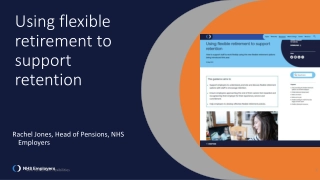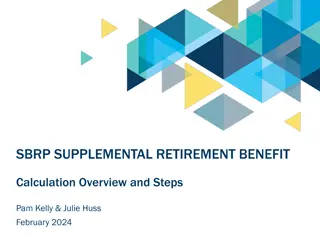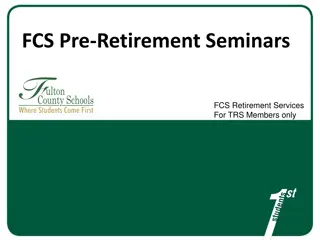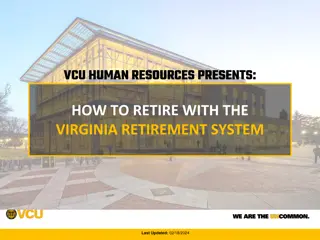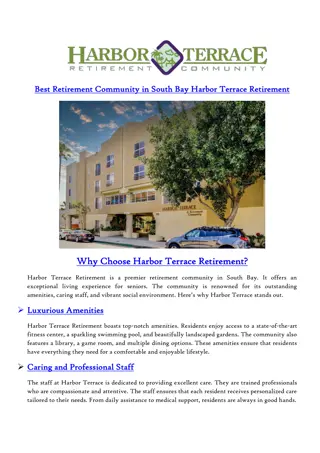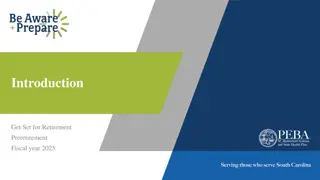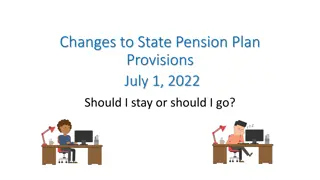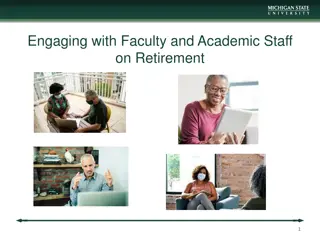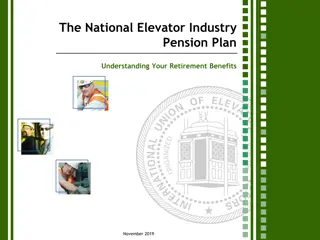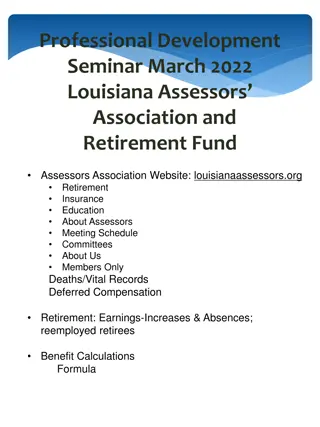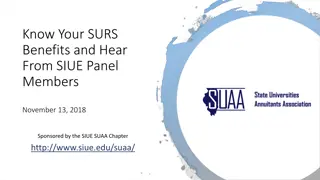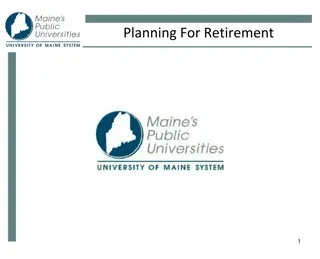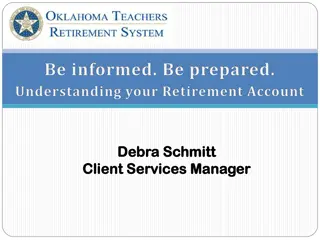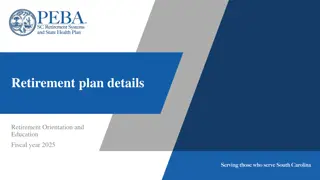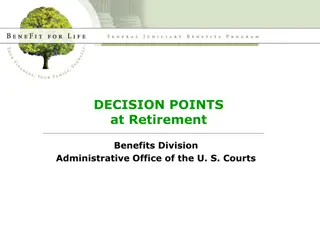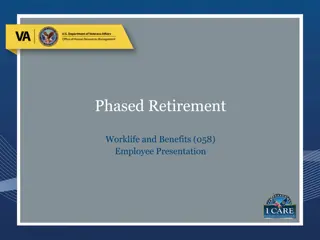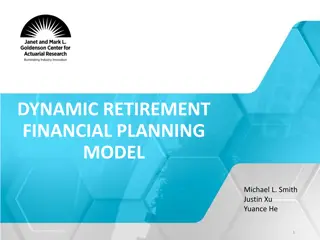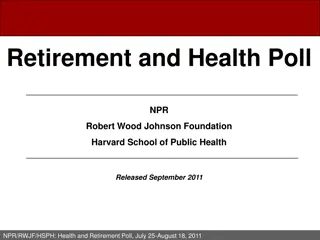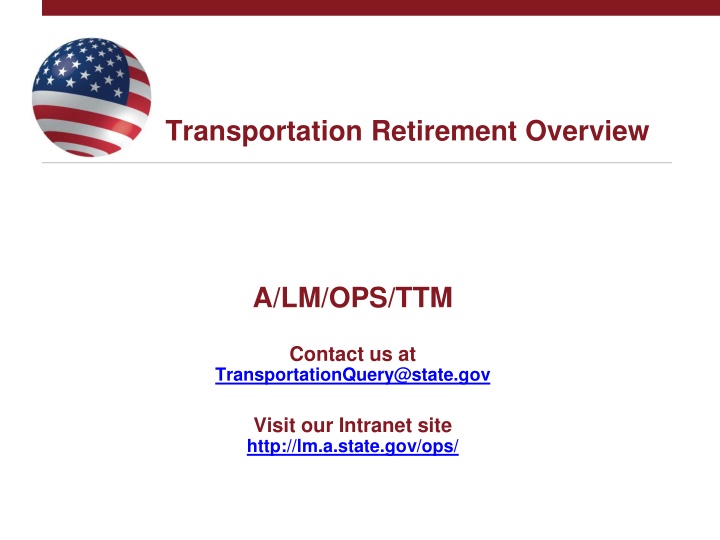
Guide to Transportation Retirement Process: Addresses, Travel Orders, and Contacts
Discover the comprehensive guide to the transportation retirement process, including details on separation addresses, submission of TM2, validity of travel orders, and contact information for key personnel. Ensure a smooth transition to retirement with all the necessary steps outlined in this informative guide.
Download Presentation

Please find below an Image/Link to download the presentation.
The content on the website is provided AS IS for your information and personal use only. It may not be sold, licensed, or shared on other websites without obtaining consent from the author. If you encounter any issues during the download, it is possible that the publisher has removed the file from their server.
You are allowed to download the files provided on this website for personal or commercial use, subject to the condition that they are used lawfully. All files are the property of their respective owners.
The content on the website is provided AS IS for your information and personal use only. It may not be sold, licensed, or shared on other websites without obtaining consent from the author.
E N D
Presentation Transcript
Transportation Retirement Overview A/LM/OPS/TTM Contact us at TransportationQuery@state.gov Visit our Intranet site http://lm.a.state.gov/ops/
HR Points of Contact 1. Human Resources Service Center: Email: HRSC@state.gov Location: Charleston, SC 2. Human Resources (HR) Technicians: Technicians generate or cut travel orders Email: HR-EX-IDSD@state.gov Location: HR-EX-IDSD International/Domestic Support Division SA-9 (Red Cross Building) Suite SE2040 (2ndFloor) transportationquery@state.gov Slide 1
Transportation Points of Contact 3. TTM Transportation Counselors (TCs): Will help with questions and implement your final move according to the instructions on your orders Phone: 202-472-8480/81 800- 424-2947 Email: TransportationQuery@state.gov Location: SA-9 (Red Cross Building), Suite SE3145A Employees retiring from one overseas location to another, the current post will assist with arranging shipment of personal effects to the retirement location. 4. transportationquery@state.gov Slide 2
Selecting Your Separation Address Final separation address is recorded on the Residence and Dependency Report (Form OF-126). The address must be in the United States or its territories Selecting a separation address on the basis for cost-construct advantage will not be considered sufficient Designation of separation address must be made Before: the effective date of retirement/last day in pay status travel orders are prepared and processed the employee or EFMs start to travel transportationquery@state.gov Slide 3
Dont Forget to Submit your TM2! Your TM2 Proposed Itinerary triggers the generation your travel orders. When employees retire, their computer accounts are deleted and their HR records are sent to archive so employees must submit their TM2-Proposed Itinerary prior to their last day in pay status. transportationquery@state.gov Slide 4
Validity of Travel Orders Whether retiring from an overseas or a domestic assignment, separation travel orders are valid for 12 months, counting from the last day on pay status Travel order can be extended 6 months for a maximum of 18 months (HR-EX) Must provide a reasonable reason for extension (house building, just not ready, etc. will not work) Any amendment or extension of travel orders must take place before the orders expire If retirement date falls near the end of the fiscal year, it may affect the issuance of your travel orders transportationquery@state.gov Slide 5
Unaccompanied Air Baggage (UAB) transportationquery@state.gov Slide 6
Household Effects (HHE) Maximum 18,000 net pounds (HHE+Storage) for each employee regardless of rank or family size Limited shipment furnished post, employee authorized to ship up to 7,200 net pounds from post to the separation address in addition to the net weight of effects in storage Full shipment unfurnished post employee authorized to ship up to 18,000 net pounds, minus the net weight of any shipments in storage Ambassadorial entitlements: An ambassador may ship 12,000 net pounds from post; however, the entire HHE shipment will be transported via surface transportationquery@state.gov Slide 7
Household Effects (HHE) All HHE must be shipped before travel orders expire - 12 months if not amended, (or 18 months if amended), counting from the last day in pay status. BUT HHE does not need to ARRIVE before the orders expire transportationquery@state.gov Slide 8
Your Separation Address & Shipments Employees can opt to retire overseas and use their U.S. separation address as the cost-construct basis to ship to a foreign country. The Employee must pay any costs that exceed the costs from their authorized origin to their official separation address. If retiring overseas, the Embassy/Consulate cannot help clear shipments through host country customs and the employee is responsible for paying all clearance fees and/or applicable duties. Personal effects or a POV acquired enroute to a place of residence upon separation will not be transported at Government expense. transportationquery@state.gov Slide 9
Storage TransportationQuery@State.gov transportationquery@state.gov Slide 10
Temporary storage Employees are granted 90 days* of temporary storage as follows: For shipments originating in the U.S. (including permanent storage): Temporary storage expires 90 days from the last day in pay status For shipments originating outside the U.S. (including storage lots from ELSO): Temporary storage expires 90 days from the date the shipment is available for delivery in the U.S. * In extenuating circumstances, HR/EX may grant an additional storage period. This must be requested before the initial 90 days of temporary storage has expired. transportationquery@state.gov Slide 11
Temporary storage When the 90 days of temporary storage expires, the employee will be personally responsible for payment of storage fees. Employees who cannot request delivery their personal effects within the authorized 90 days, and their effects are stored in a commercial storage facility, must contact the company storing the effects and make arrangements to make storage payments beyond the 90-day period. So long as the travel orders are still valid, DOS will still pay to move your goods - even if you are paying the storage fees yourself. Requesting a delivery of stored effects concludes the U.S. Government s responsibility for this entitlement transportationquery@state.gov Slide 12
Special Note About Storage at Hagerstown transportationquery@state.gov Slide 13
Timelines and Shipments From Overseas For employees retiring from an overseas post, 90 days of storage for their domestically stored storage lot(s) can expire before their ELSO storage and inbound HHE. transportationquery@state.gov Slide 14
HHE/Storage Limit Basic Recap All shipments at USG expense must be initiated prior to expiration of Travel Authorization Last Day In Pay Status Date to have all effects shipped to avoid paying additional storage costs 12 Months Validity of Travel Authorization Storage paid for at USG expense Storage fees during this period are paid for by the employee 90 Days transportationquery@state.gov Slide 15
Overweight Shipments Overweight shipments must be resolved before shipment can be initiated. Employees have two options: 1. Physically reducing the amount of effects in your shipment or, 2. Paying the actual cost of shipping the excess weight. transportationquery@state.gov Slide 16
A Quick Note about Allowances: Because employees are separating from the Service, they are not eligible Home Service Transfer Allowance (HSTA) and all of its elements, and per diem is only authorized in association with actual transit time associated with travel. For more information please contact AllowancesO@state.gov or your HR Support Technician. transportationquery@state.gov Slide 17
What does this all mean? It is the retiring employee s responsibility to: Take action to avoid incurring out-of-pocket expense after the 90 days of temporary storage expires, To initiate final delivery of their various shipments to their separation address within the validity period of their travel orders. transportationquery@state.gov Slide 18
Privately-Owned Vehicle (POV) Employees retiring from a domestic assignment or border post, are generally required to drive their vehicle to their separation address. Employees separating from an overseas location, are authorized to ship their vehicle There is no entitlement for storage of POVs at USG expense. Employees must take possession of their POV once notified the POV is available for delivery. Delivery of the vehicle concludes the U.S. Government s responsibility for this entitlement transportationquery@state.gov Slide 19
Claims . Employees are strongly encouraged to carry private insurance Two ways claims are settled. please notify your Transportation Counselor immediately or email TransportationQuery@state.gov if your effects are lost or damaged and they will provide further guidance. Small valuable items such as; jewelry, cash, smartphones, etc. should be hand-carried with you as loss of these items due to theft cannot be claimed if packed in your HHE or UAB transportationquery@state.gov Slide 20
Claims Critical Time Frames for Claims filed under the Claims Act: 75 days after delivery to file Letter of Intent (LOI) 2 years after delivery to submit completed claim 6 months from date of settlement to file reconsideration POVs damage must be reported within 72 hours, with very rare exceptions Limitations: $40,000 per single incident (including POV) transportationquery@state.gov Slide 21
Travel Management and Regulations A/LM/OPS/TTM Contact us at TransportationQuery@state.gov Visit our webpage at http://lm.a.state.gov/travel
Overview General Reminders Booking air travel with Travel Management Center Fly America Act Open Skies Agreements Rest Stops Cost Construction (Indirect Travel) TransportationQuery@state.gov Slide 23
Important Reminders Direct itinerary/route as shown on the travel authorization must be followed. Any deviation is considered indirect travel and must be cost constructed. EFM itineraries on orders will not authorize travel to Washington, D.C. for the Job Search Program. Their travel will be authorized directly to separation location. Use of GSA City Pair contract fares are mandatory where they exist. If retiring from a domestic assignment, POV is usually the authorized mode of transportation. POV shipments not authorized for domestic assignments. If you do not have a POV and will travel by air to your separation address, please be sure to specify this on My Itinerary / TMTWO. For employees coming from overseas, you may choose to ship your POV to Washington, D.C. on a cost construct basis for use while attending the Retirement Seminar or Job Search Program, however this fulfills your POV shipment entitlement. TransportationQuery@state.gov Slide 24
Important Reminders (cont.) For calendar year 2017, the POV mileage reimbursement rate for separation travel is $0.17 per mile (this includes fuel cost). When separating from service, employees are not eligible for the Foreign Transfer Allowances. When City Pair contract carrier can not accommodate pet travel as checked luggage, you may use a non-contract carrier. Form DS-4022 must be completed and traveler must pay any overage in airfare before travel agency may issue tickets. Traveler self- certifies the DS-4022; authorizing official signature not required for pet travel. Review your TMFOUR/Separation Orders very carefully to ensure your requests submitted via My Itinerary have been addressed. If information is missing or there are errors on your TMFOUR, contact your HR Support Technician in HR/EX/IDSD immediately. TransportationQuery@state.gov
Travel Management Centers (TMCs) TransportationQuery@state.gov Slide 26
Fly America Act It s the Law! General Rule Use a U.S. flag carrier for travel between U.S. and a foreign point EVEN if it is more expensive and/or less convenient for the traveler (Ref. 14 FAM 583) See 14 FAM 583 which outlines requirements and exceptions. Form DS-3093 is required when using any exception, including the Open Skies Treaties, when applicable Comparisons must be made to ALL U.S. flag carriers before a foreign flag is justified Blanket waivers are not allowable DOS, USAID, & BBG may use a foreign flag carrier for travel between any two points abroad, including a foreign leg of a trip to the U.S. (example, Guangzhou to Hong Kong on Dragon Air; however final leg from Hong Kong into the USA must ticketed with a US carrier locator and flight number, e.g. UA #2345, DL #1734, AA #0897) TransportationQuery@state.gov Slide 27
Open Skies Agreements While Open Skies agreements are common, most do not address official travel purchased with U.S. funds This inclusion is what makes the U.S.-EU Open Skies Agreement unique The U.S.-EU Open Skies Agreement essentially states that if: 1) There is no contract city pair in place between the origin and destination reflected on the travel order, or the traveler is not eligible to travel on the GSA city-pair fare, AND 2) The flight originates, transits, or ends in an EU member nation, then Equal consideration must be given to conducting travel on U.S-flag and EU member-flag carriers So, if the EU-flag carrier is less expensive, the EU carrier flight should be purchased. If the U.S.-flag carrier is less expensive, the U.S. carrier should be used. TransportationQuery@state.gov Slide 28
Rest Stops for Separation Travel Allowable on official travel in excess of 14 hours Must be taken at a connecting point on the direct, usually traveled route Must be included on the travel authorization prior to conducting travel The traveler can request a business class lounge pass in lieu of a government-funded rest stop Not authorized when traveling in premium class accommodations (unless certified as necessary by medical authority) USG-funded rest stop is forfeited if traveler cost constructs 14 FAM 584.4 TransportationQuery@state.gov Slide 29
Cost Construction (Indirect Travel) Any deviation from the most economical, direct usually traveled route for personal reasons requires a cost construct, including: Different origin or destination Different routing (requests to stop in a different city en route) Different carrier Different mode of transportation Different Class of Service The indirect travel will never be reflected on the travel authorization. May not use government airfares (including -CA, -DG, -MZ fares) for indirect travel, rather traveler must use commercial/published fares Traveler may claim only up to the cost of the fare(s) that the Government would have paid on the most economical, direct and usually traveled route Traveler no longer entitled to a USG-funded rest stop, business class lounge or extended economy seating Cost constructed travel must be done through the TMC. See TTM/Travel webpage for details when traveler has deviated from using TMC TransportationQuery@state.gov Slide 30
Final Submission of Travel Voucher Any deviation from the most economical, direct usually traveled route for personal reasons requires a cost construct, including: Different origin or destination Different routing (requests to stop in a different city en route) Different carrier Different mode of transportation Different Class of Service The indirect travel will never be reflected on the travel authorization. May not use government airfares (including -CA, -DG, -MZ fares) for indirect travel, rather traveler must use commercial/published fares Traveler may claim only up to the cost of the fare(s) that the Government would have paid on the most economical, direct and usually traveled route Traveler no longer entitled to a USG-funded rest stop, business class lounge or extended economy seating Cost constructed travel must be done through the TMC. See TTM/Travel webpage for details when traveler has deviated from using TMC TransportationQuery@state.gov Slide 31
Questions ? TransportationQuery@state.gov Slide 32

